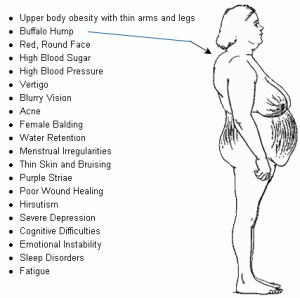What is Cushing’s Syndrome?
Cushing’s Syndrome is an endocrine disorder that occurs when the adrenal glands release too much of the hormone cortisol into the body for long periods of time.
Cortisol is essential to many of the body’s cardiovascular and metabolic functions. Two of its most important jobs are to regulate circadian rhythm and to help the body respond to stress.
Every human has cortisol receptors in nearly every tissue of their body. Normally the HPA Axis (hypothalamus – pituitary – adrenal) functions smoothly to send signals down the line to the adrenal glands to release the exact amount of cortisol necessary to meet our daily needs. In times of stress, illness, or other impact to the body, cortisol rises to help respond to the imbalance.
Sometimes an excess of cortisol is produced. Regardless of the source, over time a persistently impaired high cortisol can lead to dozens of unpleasant and dangerous signs and symptoms. It is extremely important to identify the precise cause of high cortisol when it is problematic, because an incomplete or inaccurate diagnosis could lead a patient down a path to unwarranted and invasive treatment.
The malfunction may be caused by:
- A pituitary tumor, which causes the pituitary gland (at the base of the brain) to stimulate the adrenal glands to secrete high levels of cortisol.
- A tumor on one or both of the adrenal glands (located above the kidney).
- A tumor of the lung or rarely another endocrine gland.
- Prolonged use of drugs containing some sort of cortisol product – pills, inhalers, injections, and supplements – that are commonly prescribed for diseases like asthma, rheumatoid arthritis, and lupus. There’s also an increasing problem with unlisted steroids discovered in unregulated creams and supplements for other issues.
- A non-tumor, non-steroid treatment influence within the body
The source of the high cortisol determines the official name for the diagnosis. Pituitary is Cushing’s Disease, adrenal is Cushing’s Syndrome, lung is Ectopic, mild with small slow growing adrenal nodules is MACS (mild autonomous cortisol secretion), non-tumor source is Non-Neoplastic Hypercortisolism (thankfully the offensive term “pseudo-Cushing’s” is going out of style), and the type caused by taking steroid medications is called Exogenous Cushing’s. There are more terms you might hear depending on where you live and how much expertise your doctor has with diagnosing, treating, and managing Cushing’s. Trace it back to the source.
What are the symptoms of Cushing’s Syndrome?
There is no single symptom shared by everyone with Cushing’s Syndrome, however, some symptoms occur more frequently than others.
Who Gets It?
Cushing’s Syndrome is relatively rare. An estimated 5-15 people per million are diagnosed with pituitary-source Cushing’s Disease each year. Estimates are updating often with new data, but the estimated number of patients diagnosed with non-pituitary Cushing’s Syndrome is around 50 people per million. It is most common in adults between the ages of 25 and 55 years old, although it can occur at any age. it affects women five times more frequently than men.
What Should I Do If I Think I Have Cushing’s?
Make an appointment with your physician immediately. Tell them about your symptoms. Take pictures that show what you looked like prior to having symptoms of Cushing’s. Ask for screening. More and more non-specialist doctors are willing to screen these days, and we support that wholeheartedly!
The initial screening for any form of Cushing’s Syndrome consists of a review of the patient’s medical history, a physical exam, and laboratory tests that will help to determine if excess levels of cortisol are present in the body but will also look at other markers that could help identify what’s making the patient sick. We strongly recommend asking for a full hormone panel and a synthetic hormone screening panel if you can get them, because it’s helpful to know if your other hormones are balanced and if you may be inadvertently consuming or absorbing products with steroid in them.
Since Cushing’s is a disease marked by persistent high cortisol over time, it is important to get a second set of cortisol screening tests a short time after the initial screening is done. The only “fast” case is a strongly overt one, with every test coming in several times the upper limit of normal and clear findings on an MRI or CT scan. We encourage as much patience as you can tolerate during this stressful time, but make sure to ask for clarification on next steps and timelines if your doctor does not explain them in a way that you understand at first.
Once Cushing’s has been diagnosed, it is important to find the cause of the cortisol overproduction. There are a number of procedures, scans, and tests that can help your doctor determine the best plan of action to address your particular type of high cortisol. Depending on the source of high cortisol, treatments include surgery, medical therapy, and radiation.
Updated 2025-08




